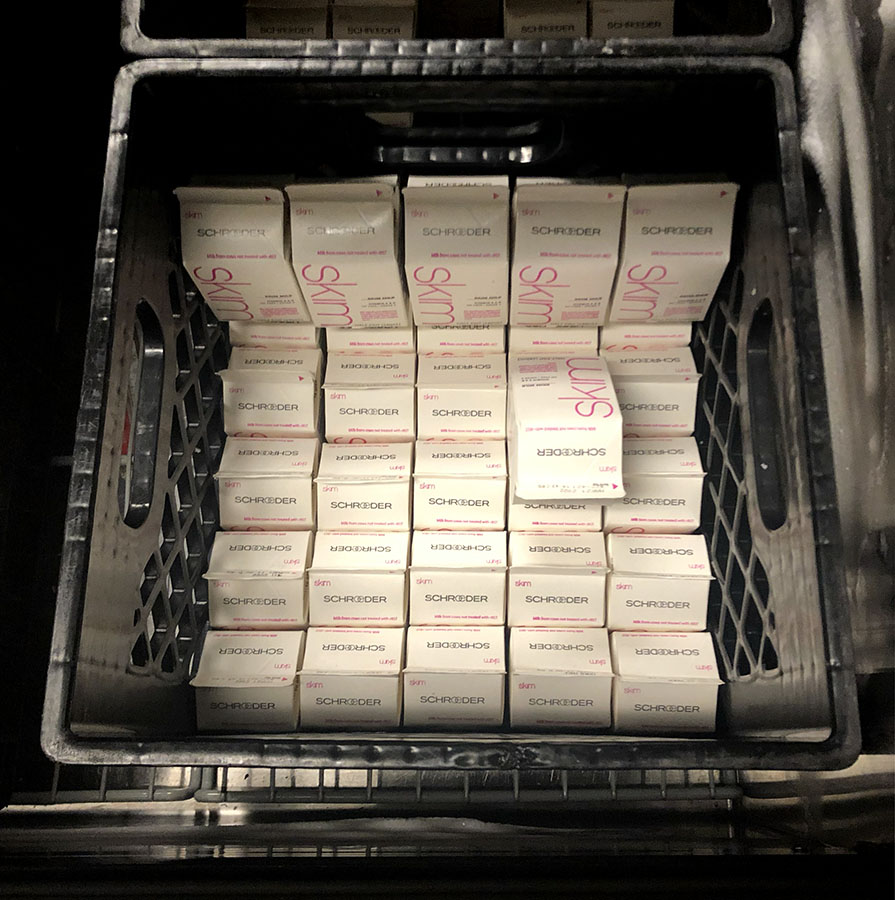Is our obsession with dairy rooted in violence and racism?
A crate full of skim milk cartons in South’s cafeteria is pictured here. With South’s diverse and mostly non-white student body, the majority of which statistically cannot digest dairy, is it really the correct way to operate a lunchroom?
March 31, 2022
Before globalization, dairy cows were mainly concentrated in India, China, North Africa, some parts of Europe, and the Middle East. Now they are spread nearly worldwide, through colonization and global trade. Even though they are a staple of American cuisine and countless other food cultures, the majority of people in the world cannot digest lactose because they naturally have a lack of the lactose-processing enzyme lactase. In addition, milk’s nutritional properties are greatly exaggerated by marketing campaigns. The narrative of needing milk for strong bones and growth, or chocolate milk as a recovery drink, or even things like healthy yogurt and cheese are built from marketing schemes aimed at preserving the wealthy dairy industry. Subsidized milk products are force fed in prisons, schools, and food stamps programs, mostly to people that both cannot digest them and have no alternatives. South High’s lunch program continues to stock hundreds of milk cartons every day. Even though they are not forced into students’ hands, it might be time to rethink our belief that it’s healthy.
While dairy is consistently touted as a calcium-rich superfood, it’s actually really only necessary in the early stages of life. And according to the Physicians Committee for Responsible Medicine (PCRM), “Milk and other dairy products are the top source of saturated fat in the American diet, contributing to heart disease, type 2 diabetes, and Alzheimer’s disease. Studies have also linked dairy to an increased risk of breast, ovarian, and prostate cancers.” Many of these are more prevalent among African Americans, especially cardiovascular disease and diabetes. The marketing goes one step further to especially advertise to people of color, notably in the “Got Milk” campaign.
While a lot of this dairy marketing exists in dairy-positive campaigns, it also exists in the federal subsidization of new high-dairy products like Pizza Hut’s Stuffed Crust Pizza and Taco Bell’s Quesalupa. In addition, these programs are responsible for more milk in coffee drinks, more cheese on McDonalds breakfast sandwiches, and countless others. Watch nearly any television commercial break and there will be at least a couple advertisements that rely on our conditioning to salivate over ridiculous amounts of cheese.
On top of marketing strategies, the federal government has also continued to implement racist dairy-related policies. According to Dr. Milton Mills, associate director of the PCRM, “The U.S. Dietary Guidelines as they exist are really a fundamental form of institutionalized racism in a rather destructive and insidious format.” Things like the Federal Milk Program for Schools and the US Dietary Guidelines that recommend all Americans above the age of two to consume multiple servings of dairy every day directly affect millions of Americans. The food stamp and prison programs, which mostly cater to low income people of color, and are also often used to get rid of massive amounts of excess dairy products previously bought by the federal government in order to maintain dairy prices, display the ignorance of these decisions. They end up with lactose intolerant people of color having no other option but to eat food they cannot digest. Are these policies built for all Americans? Or for white Americans?
Dairy cows were originally introduced to North America by Christopher Columbus, and were brought to what is now the United States about 100 years later. A symbol of colonization, cattle helped to pave the way for western expansion of the settling colonies and fueled the to-be nation’s growing economy. The dairy industry expanded, as cows and the livelihoods they created became a part of our very culture. Many of the settlers had their own cows, and cowboys and ranches dominated the west.
Fast forward a few hundred years and dried milk powder is being used as a relief food for soldiers during WWII. It was compact, relatively easy to mass produce, and a quick source of calories. But while the government needed large amounts of these products, there wasn’t enough demand for them at home to make it viable for the industry. So, the federal government utilized marketing to transform their industrial and agriculture base. After the war, the booming dairy industry lost a huge share of its market, and seemed on the verge of declining due to low demand and prices. The federal government stepped in again with marketing, and this time sold everything dairy related as a health food. Milk, cheese, cream, anything with dairy was advertised as the keystone to a balanced diet. This was also when the Federal Milk Program for schools was created, making milk cartons mandatory lunch items.
The South High cafeteria offers a wide selection of drinks: 2% and skim milk. With South’s diverse and mostly non-white student body, the majority of which statistically cannot digest dairy, is it really the correct way to operate a lunchroom? There isn’t even a need to get rid of it; maybe just add some new options to the menu.






